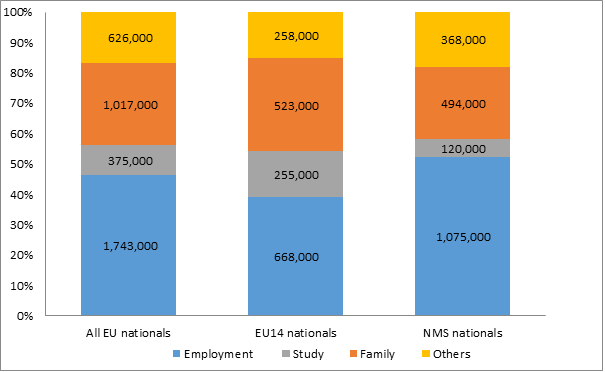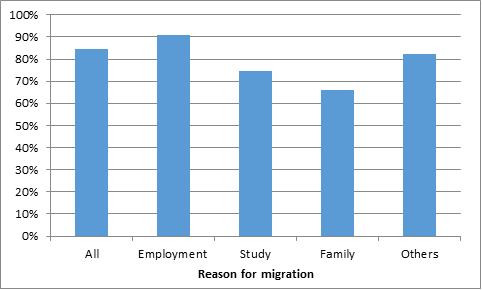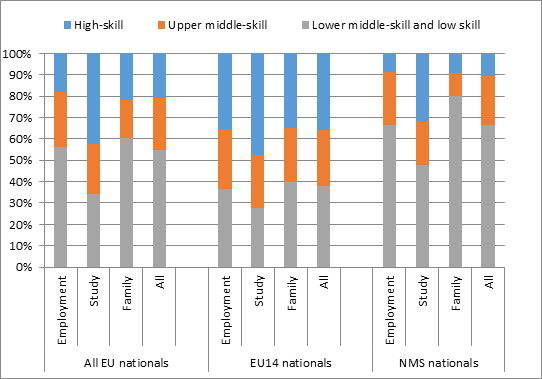This blog was previously published on the REMINDER project blog.
One implication of leaving the European Union and ending freedom of movement is that the UK has to rethink the right of EU nationals to live and work in the country. A key question in this context is: what are the potential implications of modifying the access of EU nationals to the UK and its labour market? In order to answer this question, it is necessary to look at the employment characteristics of EU nationals working in the country. In principle this is an easy task, as there are multiple academic articles exploring the economic outcomes of EU nationals in the UK.
However, a closer look at many of these articles reveals a broader limitation. The full heterogeneity of the EU workforce is not taken into account. Many articles divide the sample between those coming from countries that were members of the EU before 2004 (EU14) and those coming from newer EU member states (NMS).[1] Yet, even within these two groups, there is substantial variation in reason for immigration to the UK. Some EU nationals moved to the UK in order to find employment, others to study, others to join or accompany family members, and many more reasons. The heterogeneity of EU nationals regarding the reason for immigration has been largely ignored in the literature. This is an important limitation, as any new immigration rules applied to this group are likely to make distinctions based on route of entry and reason for migration. That is, it is likely that one set of rules will apply to those coming for work, different rules will apply to those joining family members, and other rules will apply to those coming to the UK for study reasons.
This blog draws on research from the REMINDER project, and uses confidential labour market data from the UK to inform the discussion on the country’s post-Brexit immigration policy. In particular, we explore the composition of the current population of EU nationals in the UK based on original reason for immigration, and explore differences in employment characteristics among EU nationals who migrated for different reasons.[2]
Why do EU nationals move to the UK?
There were 3.8 million EU nationals living in the UK as of 2017 (excluding British nationals), comprised of 1.7 million EU14 nationals and 2.1 million non-EU14 nationals. A key question is, why did these EU nationals moved to the UK in the first place? Before answering this question, it is important to highlight that 8% of EU nationals in the UK were actually born in the country. From those EU nationals who were born abroad, 46% originally migrated to the UK for work reasons, 27% for family reasons, 10% for study reasons, and 8% for other reasons (see Figure 1). This suggests that, while migration for work is at the centre of discussions relating to Brexit and the future relationship between the UK and the EU, half of EU nationals living in the UK migrated to the country for other reasons.
Comparisons across groups of EU nationals (EU14 and NMS) also reveal interesting patterns. First, the share of those who migrated for study reasons is twice as large among EU14 nationals compared to NMS nationals. Note that the reasons for migration discussed here do not refer to current main activity. For instance, a large share of those in this study category are no longer students. These individuals originally came to the UK to study and decided to stay in the UK after finishing their studies. Second, the share of those who migrated for employment reasons is 50% greater among NMS nationals than among EU14 nationals. In fact, non-EU14 nationals make up three-fifths of all EU nationals who migrated for employment reasons, but only a third of all those who migrated for study reasons.

Figure 1 – Original reason for immigration of EU nationals living in the UK during 2017. Note: “Others” includes those who initially migrated to visit, UK-born and those with unknown reasons for migration.
The differences between the EU14 and NMS groups are driven by nationals of a few countries. For instance, estimates suggest that nationals of Poland and Romania account for more than two-fifths of all those who migrated for work reasons. Nationals of France and Italy account for a quarter of all those who migrated for study reasons. Finally, Polish nationals account for a quarter of all those who migrated for family reasons.
What are the economic implications of people’s reasons for migration?
Here we focus of those of working age (between 16 and 64 years) to explore differences in employment characteristics between EU nationals who migrated for different reasons. Unsurprisingly, EU nationals who migrated for employment reasons have the highest employment rates (over 90%). The employment rates are also high among all groups of EU nationals. The group with the lowest employment rate is family migrants, who have an employment rate of 66%. However, even in that case, the employment rate is higher than that of non-EU nationals (just over 60%).[3]

Figure 2 – Employment rates of EU nationals in the UK by reason for immigration, 2017 (in %)
The analysis above suggests that reason for immigration could account for differences in the employment rate of EU nationals. It is also possible that differences regarding reason for immigration have implications for the types of jobs that EU nationals do. As a final exploration, we look at occupational differences. For this purpose, we use a classification that groups jobs according to the skill requirements of the position.[4] As the title suggests, ‘High-skill’ occupations refers to jobs that require the highest level of skill (e.g. engineers, pharmacists, university professors), followed by ‘upper middle-skill’ occupations (e.g. paramedics, police officers, fitness instructors). ‘Lower middle-skill’ and ‘low skill’ occupations require the lowest level of skill (e.g. agricultural workers, cleaners, machine operatives).
The majority of EU nationals working in the UK are employed in lower middle-skill and low skill occupations. EU nationals account for about one-tenth of all those working in these occupations, which is about twice as much as the corresponding share of those who work in occupations with higher skill requirements. As such, EU nationals represent a considerable share of the workforce in these types of jobs.
There is a sharp contrast in occupational distributions between nationals of EU14 countries and those of NMS, even within the same reason for immigration. Regardless of reason of immigration, lower middle-skill and low skill occupations account for the greatest share of jobs done by nationals of countries that joined the EU from 2004 onward. In contrast, the occupational distribution of EU nationals from countries that were members of the EU before 2004 is more evenly distributed across the different reason for immigration groups, although those who originally migrated for study reasons have the greatest likelihood of being in a high-skill occupation.

Figure 3 – occupational distribution by reason for immigration, 2017 (in %)
Implications for post-Brexit immigration policy
The findings above have significant implications for any post-Brexit immigration policy towards EU nationals. First, there has been a large amount of discussion regarding the optimal post-Brexit labour immigration policy of the UK.[5] The discussion of other post-Brexit migration routes has been disconnected from labour market issues and potential shortages of skills. Yet this narrow focus on policies related to migration for employment reasons misses the bigger picture, as a substantial share of EU nationals working in the UK have migrated for others reasons.
Second, as we move beyond labour migration routes, there are many factors to be decided during the next few years that will have major implications for the future EU workforce in the UK. For instance, most EU nationals currently pay the same fees as UK home students throughout their degree. Would EU students be able to access education in the UK under the same terms that they do now (i.e. fees, funding, visas)? Would they be able to stay and work in the country after finishing their studies? Under what conditions? Since EU nationals coming to the UK for study reasons are the group that has the largest share of workers in high-skill occupations, policies designed to prioritise high-skilled migration (as the UK Government currently supports) need to take into account migration for study and the transition from study to work. If to study in the UK becomes more expensive and the transition to work is harder, this could have a knock-on impact, reducing skilled EU workers.
Likewise, what requirements would those migrating from the EU as family members face? Currently, the UK requires a minimum income for the sponsorship of visas for non-EU spouses.[6] EU nationals are currently exempt from this income threshold given the rules governing freedom of movement. Would this change in the future and in what ways?
The withdrawal agreement agreed between the EU and UK,[7] as well as the white paper on The UK’s Future Skills-Based Immigration System,[8] contained partial answers to these questions. However, in the current political climate and with the uncertainty about the future EU-UK relationship there is major uncertainty about these and related questions.[9]
[1] Drinkwater, S., Eade, J., & Garapich, M. (2009). Poles apart? EU enlargement and the labour market outcomes of immigrants in the United Kingdom. International Migration, 47(1), 161-190.
[2] The data used in the article come from the secured access version of the 2017 UK Labour Force Survey produced by the Office for National Statistics (ONS) and supplied by the UK Data Service. The use of the data in this work does not imply the endorsement of ONS or the Secure Data Service at the UK Data Archive in relation to the interpretation or analysis of the data.
[3] See Office for National Statistics, UK and Non-UK People in the Labour Market: August 2017, ONS: London.
[4] Office for National Statistics. (2010). SOC2010 volume 1: structure and descriptions of unit groups. Available here.
[5] Madeleine Sumption and Mariña Fernández-Reino, Exploiting the Opportunity? Low-Skilled Work Migration After Brexit, 2018, Migration Observatory Report.
[6] Madeleine Sumption and Carlos Vargas-Silva, Love Is Not all you Need: Income Requirement for Visa Sponsorship of Foreign Family Members, Journal of Economics, Race and Policy (2019) 2: 62. https://doi.org/10.1007/s41996-018-0022-8
[7] UK Government, Withdrawal Agreement and Political Declaration, 2019. Available here.
[8] White paper on The UK’s Future Skills-Based Immigration System, available here.
[9] Thanks to Madeleine Sumption for helpful comments and feedback on this research.
